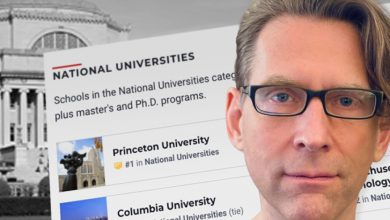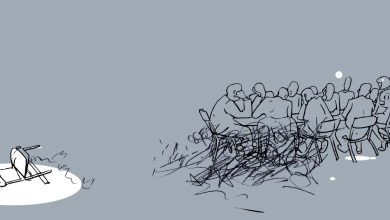With Students in Mental-Health Crises, Campuses Risk Doing Too Little — or Too Much

[ad_1]
Overwhelmed by her six courses and feeling there was no way to catch up, the 21-year-old junior was terrified that failing one could jeopardize a summer internship and her financial aid. She had been pleading for help to drop a course, but the adviser who needed to sign off on the late withdrawal was out of the country. She hated herself, Kong said, she was having panic attacks, and she saw no way out.
The doctor advised her how his office might be able to help during regular business hours but didn’t consider her situation dire enough to break confidentiality and call her parents.
Three days later, on an April morning in 2016, Kong died by suicide at a nearby subway station.
Her parents sued Penn in 2018, alleging that the university had failed to heed ample warnings that their daughter’s life was in serious jeopardy. Multiple Penn professionals had been told at least nine times that Kong was considering ending her life, the lawsuit said, but that information was never shared with her parents.
Last month they settled with Penn for an undisclosed amount. University officials did not respond to requests for comment on either that settlement or how they deal with other severe mental-health crises.
Kong’s case shined a spotlight on tensions that have since been sharpened by the Covid-19 pandemic, with resources tight, staff burned out, and the demand for services growing.
Mental-health professionals want students to trust in the confidentiality of treatment sessions, but when the risk of suicide is imminent, college administrators are under pressure to share that information and potentially send students home. Assessing that risk is one of the hardest judgments they’ll be asked to make. The legal and personal consequences can be devastating if they do too little, or too much.
“In general, confidentiality is a rule,” said Carol Nelson Shepherd, a lawyer for Kong’s family. “The big question is when is it necessary or permissible to breach confidentiality in order to save the life of a patient.”
A leave of absence may be the best thing for a student in crisis, but if it’s forced it can lead to feelings of betrayal and deprive the student of on-campus support. Sometimes it can worsen a mental-health crisis.
Plaintiffs in a class-action case that was settled at Stanford University in 2019 accused the university of coercing them into taking involuntary leaves, or leaves that were “voluntary” in name only. Some said that they were banned from campus after seeking help and that their mental illnesses were treated more like behavioral infractions.
In a compromise designed to balance student rights and campus safety, Stanford revised its policies to give students much more control over leaves of absence, and more options for accommodations if they decide to stay.
“Those are the two tensions,” said Karen Bower, a civil-rights lawyer in Washington, D.C. “You’ve got disability law on the one hand and lawsuits against universities for failure to prevent suicide.”
Bower has represented students who have sued their colleges, claiming they discriminated against students with mental-health disabilities by barring them from campus. In the past, she said, courts tended to tell colleges: “You can’t be so fearful that you’re kicking out students with disabilities.”
Stuart Seaborn, managing director of litigation at the nonprofit Disability Rights Advocates, which represented students in the Stanford case, said it’s important for colleges to recognize that this is a civil-rights issue.
“Mental-health disability is a disability,” Seaborn said. “As long as those students don’t present a direct threat to the health and safety of the community, they should be accommodated.”

Recently, Bower said, the courts have been “more willing to recognize the special relationship between students and universities, in limited circumstances.” That means that the courts recognize “a minimum that universities should do for suicide prevention,” she said.
For years, Bower has advocated for more options for students with mental-health disabilities. Accommodations might include allowing students to take classes online, giving them extra time to finish a course, and letting them withdraw from some classes rather than from the whole semester so they don’t lose financial aid that requires full-time status. She believes students should participate in the decision-making process.
Sending students home can disrupt the support system that they may have set up on their campus. Going home in the middle of the semester when the rest of your friends are in college is a daunting and isolating prospect, Bower said, even for someone who isn’t depressed.
That’s particularly true for students who have fewer resources at home, said Victor Schwartz, senior associate dean of student wellness at the City University of New York Medical School.
“They have a harder time getting care,” he said. “The supports aren’t as available.”
Back home in Calipatria, Calif., a small, poor town in the desert, Escalon had been at the top of his class. When he arrived at Harvard University on a full scholarship, he was surrounded by students who were not only better prepared for college coursework, but much wealthier. They didn’t seem to be struggling like he was.
Escalon began seeing both a campus therapist and a nurse practitioner who prescribed him an antidepressant that he did not like because of its effects on his sleep and appetite.
When Escalon had anxiety attacks, he would go to the health-services center, see a practitioner, and occasionally spend the night, he said. He also spoke regularly to his dorm’s proctor, a graduate student who lived in the all-freshman dorm, and to his peer-advising fellows, undergraduate upperclassmen who advise first-year students. At Harvard, there are also residential deans who oversee the first-years’ dorms.
A pattern developed. Each time Escalon sought care, whether by visiting the health center or talking to one of the student advisers, he said he would get an email from his residential dean. He was eager for help, but he began to realize that when he got it, he couldn’t expect privacy.
“It started to feel odd,” he said. “It felt like a really insular system of advisers, proctors, the dean, and health services. It felt like I couldn’t interact with one without interacting with another element.”
Escalon said he tried to explain to the nurse practitioner that he didn’t like the medication he was on. She changed the dosage, but that didn’t help, he said. Eventually, without telling her, he stopped taking it altogether. For a few days, he spiraled until he found himself sitting on the floor, feeling out of options. In what he now describes as an impulsive decision, he took 12 of his antidepressants.
Escalon spent about two days in the hospital, during which he heard from his residential dean regularly. “It felt like the dean was now on my case,” he said.
He returned to Harvard’s health-services center. At one point, he said, he opened the door of his room and saw two Harvard police officers outside. That signaled to Escalon that Harvard now viewed him as a liability, not just to himself, but to the university.
“It was really hard to tell who was being cared for. Was it me or the university?” he wondered.
An ambulance took Escalon to McLean Hospital, a psychiatric hospital in Belmont, Mass. The dean was there when he arrived and stayed with him while he checked in, he said. According to Escalon, the dean explained that if he didn’t admit himself, he risked being involuntarily admitted, which would involve the courts. He decided to go along with it and do whatever necessary to get out of McLean.
“While I’m in McLean, my priority is not my mental health,” he said. “My priority is getting out of what felt like a punishment.”
The dean made regular visits to bring him clothes and check in. He believes that she cared for him and wanted to help, but she also had to consider the university. On one visit, Escalon said she strongly suggested he take a voluntary leave of absence. She pointed out the number of times he had sought care at the health-services center, where he regularly met with a therapist and nurse, and to get treatment for his asthma.
Escalon believes now that he needed some time away from campus. But it felt like he was being penalized for his mental health.
“I don’t disagree with the decision; I disagree with the process,” he said. “It started to feel like I was no longer part of the decisions that were being made on my behalf.”
Escalon went to Fresno, Calif., where his mother lived and where the 2009 job market was a little better than in Calipatria. He worked for a dry cleaner for three months before getting laid off. He then got a seasonal position at Home Depot, where he worked for another three months. He also had to see a therapist as a condition of his leave. But he felt like he couldn’t be completely honest with her because she would eventually write a letter saying whether or not Escalon was ready to be readmitted to Harvard.
He was readmitted, and is now working toward a Ph.D. in the study of religion at the University of Toronto. But, he said, it took years for him to feel like he could be honest with mental-health professionals again.
When asked about this case and about how the university decides when to suggest a leave of absence for a student, Harvard pointed to its student handbook, which notes that depending on the circumstances, students may take voluntary or involuntary leaves of absence for medical reasons.
“Following an individualized assessment, for students on a medical leave of absence, the College may set out specific expectations for them to meet before they may return to the College with the goal of ensuring their readiness to return,” the handbook states about voluntary leave.
A Rice University student had a similar experience. The student, who asked that his name not be used because he is currently on a leave of absence and hopes to be readmitted, said he has struggled with his mental health for years, which led to a suicide attempt.
He said his psychiatrist told him that, with the right medication, he’d be able to return to his life. The student said he tried to explain this to Rice officials, but they insisted he take a leave of absence. According to the student, an administrator told his parents that the university viewed him as a liability.
Not only could the student not return to classes, he said, he is not allowed on campus. Being separated from his friends and a job he loved left him despondent. He said he lost all trust in Rice as an institution.
“They have this whole process that is apparently emphasizing the well-being of their students,” he said. Now he saw that as a “huge guise from which they can treat students like a liability.”
A Rice spokesman told The Chronicle in an email that the university “offers students who are struggling with mental health as many options as possible, including on-campus counseling through the Wellbeing and Counseling Center, academic accommodations, and voluntary medical leaves of absence.” He said that “involuntary medical leaves are a measure of last resort and extremely rare” and that other alternatives or accommodations are always considered. Students also have the right to appeal to the provost within 48 hours of being placed on leave, he said.
Two decades ago, Lake said, colleges were too quick to send home students who appeared to be contemplating suicide. Today, he said, they’re more likely to determine whether the campus has the environment and resources to help a student with specific needs.
Even with comprehensive risk assessments, it’s extremely hard to predict whether someone who’s confided suicidal thoughts will follow through on them.
In 2020, in the early months of the pandemic, about one in five of the more than 18,000 college students surveyed by the Healthy Minds Network and the American College Health Association reported having suicidal thoughts in the previous two weeks. The survey, of students on 14 campuses, found that the rate of depression had risen during the pandemic.
“There’s a huge population of people who are at risk, some of them imminent, but only a small fraction of those will complete,” Lake said. Many more could be supported and accommodated on campus if the right protocols and safety nets were in place.
Still, the threat of lawsuits, damage to the college’s public image, and worries about stress to students around them or so-called suicide contagion can prompt institutions to send a student home, and to quietly settle with grieving families.
“When someone dies by suicide, naturally and appropriately there’s a high level of accountability,” Lake said. “Because completed suicides are rare, the handful of situations will be scrutinized like plane crashes.”
In one system, legal fallout from a suicide prompted a policy overhaul. In 2018 the Massachusetts Association of Community Colleges, or MACC, developed a systemwide protocol “to identify, assess the risk of, intervene in and respond to suicidal behavior.” It was prompted by a landmark decision in a wrongful death case against the Massachusetts Institute of Technology. Although MIT was found not responsible for the student’s suicide, the court said that in certain circumstances, a “special relationship” between a university and student could mean a duty to take “reasonable measures to prevent suicide.”
That’s a challenge at community colleges, where students generally live off campus, and many are struggling with family, work, and school responsibilities and are often in precarious financial situations, said David Podell, a psychologist who heads MACC’s Council of Presidents. While students at MIT might be struggling more with intense academic workloads and perfectionist tendencies, “Our students are differently vulnerable,” said Podell, who is also president of Massachusetts Bay Community College.
Each campus modified the protocol to suit its students. At Middlesex Community College, for instance, someone who has stated plans to end their life may need a sign-off from a mental-health professional before returning to the classroom, and if the suicide protocol is activated, the student’s parents or other emergency contacts might be notified.
“I don’t think academic-affairs people realized what a crisis she was in,” he said of Olivia Kong. “There was no one there to shepherd her through the process.” So many of the stressors students face are academic and could be eased with reduced course loads, flexible deadlines, and other academic accommodations, he said.
One of the first steps campus therapists should take, and don’t often enough, Sokolow said, is to explain how other offices and resources can be part of a broader safety net. They might show students a flowsheet with other campus resources and ask which ones they’d be comfortable sharing information with.
After the 2007 mass shooting at Virginia Tech raised questions about campus mental-health care and patient confidentiality, “one thing everyone realized was the reliance on counseling centers was a blessing and a curse,” Sokolow said. “Once a student is referred to counseling, they kind of disappear into a black hole.” Collaborative interaction might have helped, but “How do we craft that,” he asked, “given confidentiality requirements and the boundaries students want where they can safely disclose sensitive information?”
Campus counseling centers try to strike that balance. ”We’re probably the most confidential location on campus,” said Raime Thibodeaux, president of the American College Counseling Association.
Counselors can share details only if the student has signed a release authorizing it or if the counselor believes the student might harm themself or others.
“I usually explain to students,” Thibodeaux said, “if there ever was a situation where we’re talking about a limitation to confidentiality, a time when I might need to do a breach, I would, where possible, let you know about it.”
Sometimes other administrators might ask about a student, with good intentions, Thibodeaux said, and counselors will then explain the confidentiality code. Even though counselors on campuses serve both the students and the institution, Thibodeaux said, like any therapist, their ultimate fidelity is to the patient. “That, for us, supersedes just about everything else.”
If you are in crisis and would like to talk to someone, you can call the National Suicide Prevention Lifeline at 1-800-273-TALK (8255) or text “HOME” to the Crisis Text Line at 741741. Both services are free, confidential, and available 24/7.
[ad_2]
Source link






